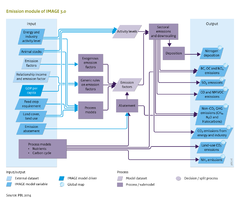Emissions/Description: Difference between revisions
Jump to navigation
Jump to search
Oostenrijr (talk | contribs) m (Text replace - "NOx" to "NO<sub>x</sub>") |
Oostenrijr (talk | contribs) m (Text replace - "SF6" to "SF<sub>6</sub>") |
||
| Line 56: | Line 56: | ||
# Cement and steel production. IMAGE-TIMER includes detailed demand models for these commodities (Component [[Energy supply and demand]]). Similar to those from energy use, emissions are calculated by multiplying the activity levels to exogenously set emission factors. | # Cement and steel production. IMAGE-TIMER includes detailed demand models for these commodities (Component [[Energy supply and demand]]). Similar to those from energy use, emissions are calculated by multiplying the activity levels to exogenously set emission factors. | ||
# Other industrial activities. Activity levels are formulated as a regional function of industry value added, and include copper production and production of solvents. Emissions are also calculated by multiplying the activity levels by the emission factors. | # Other industrial activities. Activity levels are formulated as a regional function of industry value added, and include copper production and production of solvents. Emissions are also calculated by multiplying the activity levels by the emission factors. | ||
# For halogenated gases, the approach used was developed by Harnisch et al. ([[Harnisch et al., 2009|2009]]), which derived relationships with income for the main uses of halogenated gases (HFCs, PFCs, | # For halogenated gases, the approach used was developed by Harnisch et al. ([[Harnisch et al., 2009|2009]]), which derived relationships with income for the main uses of halogenated gases (HFCs, PFCs, SF<sub>6</sub>). In the actual use of the model, slightly updated parameters are used to better represent the projections as presented by Velders et al. ([[Velders et al., 2009|2009]]). The marginal abatement cost curve per gas still follows the methodology described by Harnisch et al. ([[Harnisch et al., 2009|2009]]). | ||
===Land-use related emissions=== | ===Land-use related emissions=== | ||
Revision as of 10:39, 1 July 2014
Parts of Emissions/Description
| Component is implemented in: |
Components:and
|
| Projects/Applications |
| Models/Databases |
| Key publications |
| References |
|
